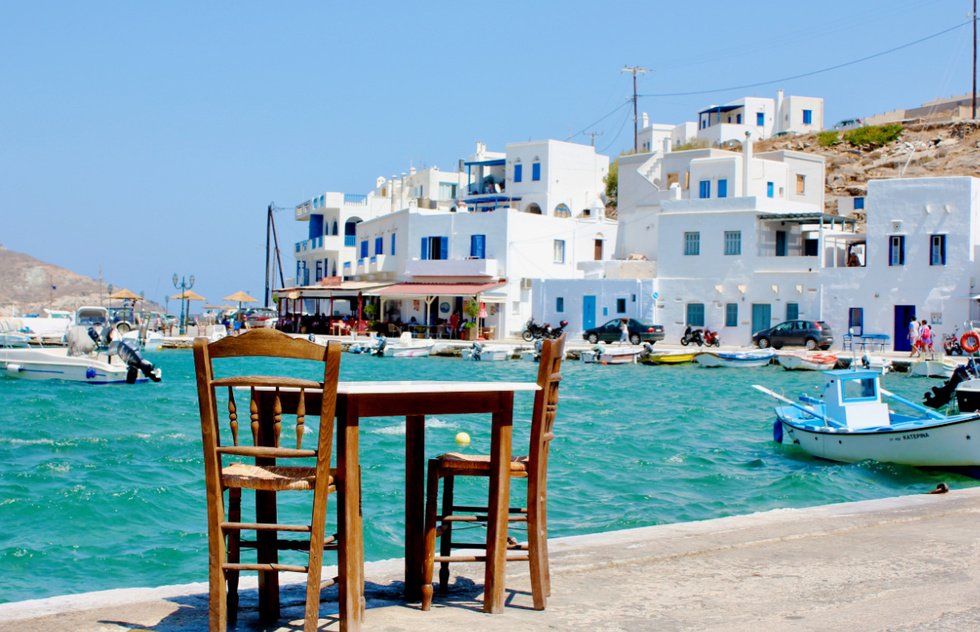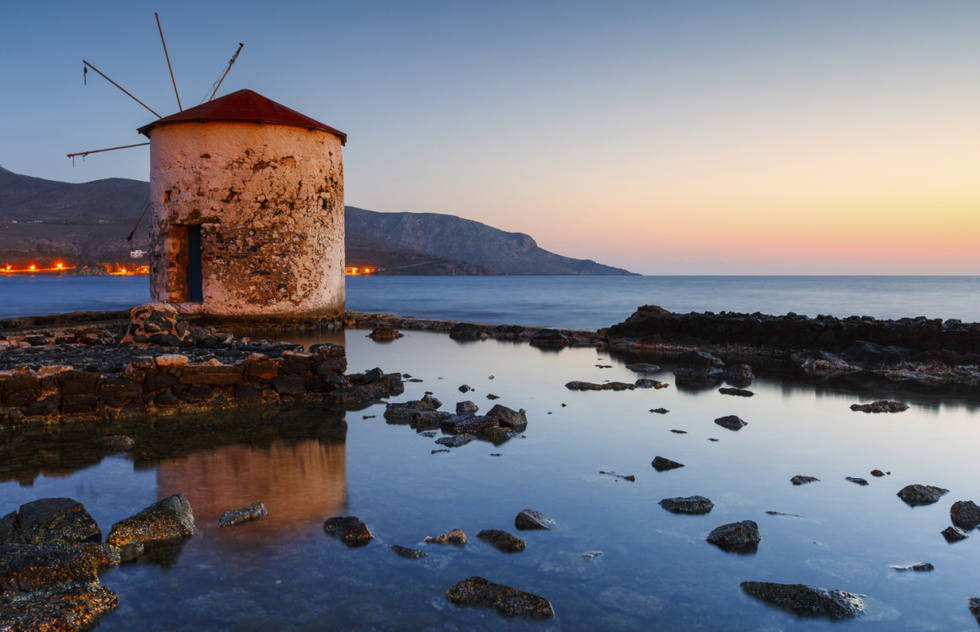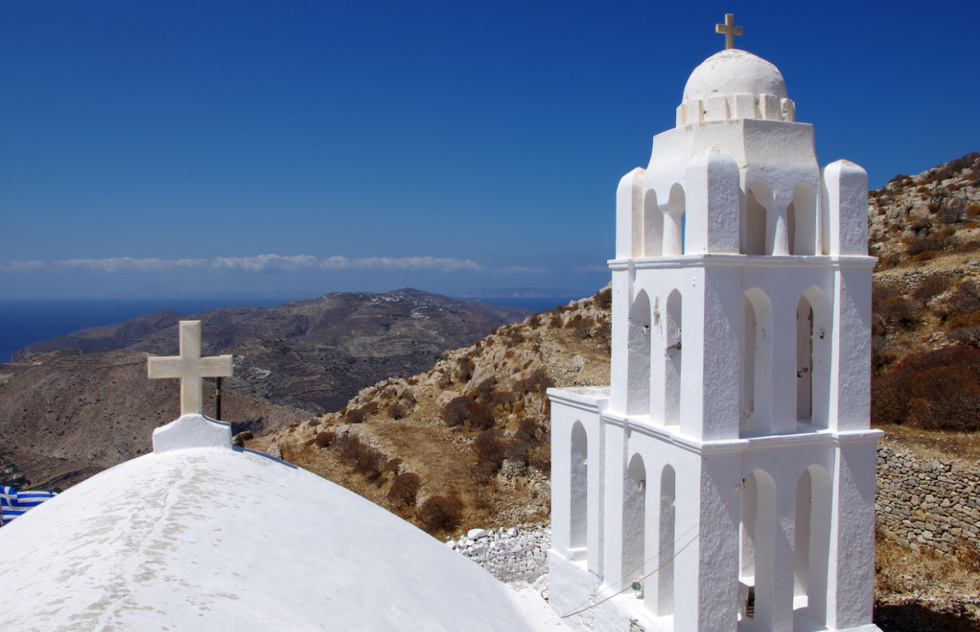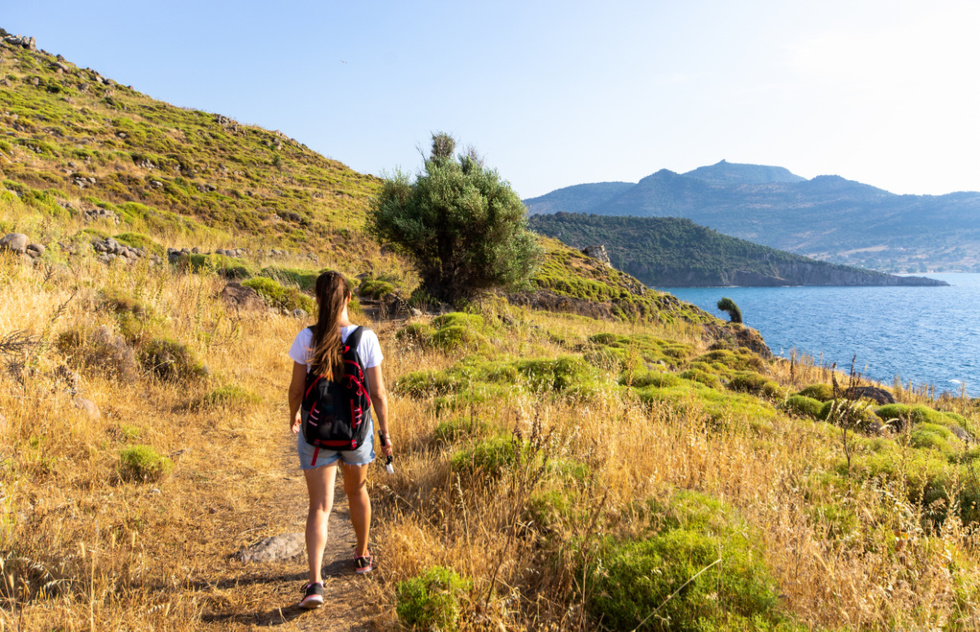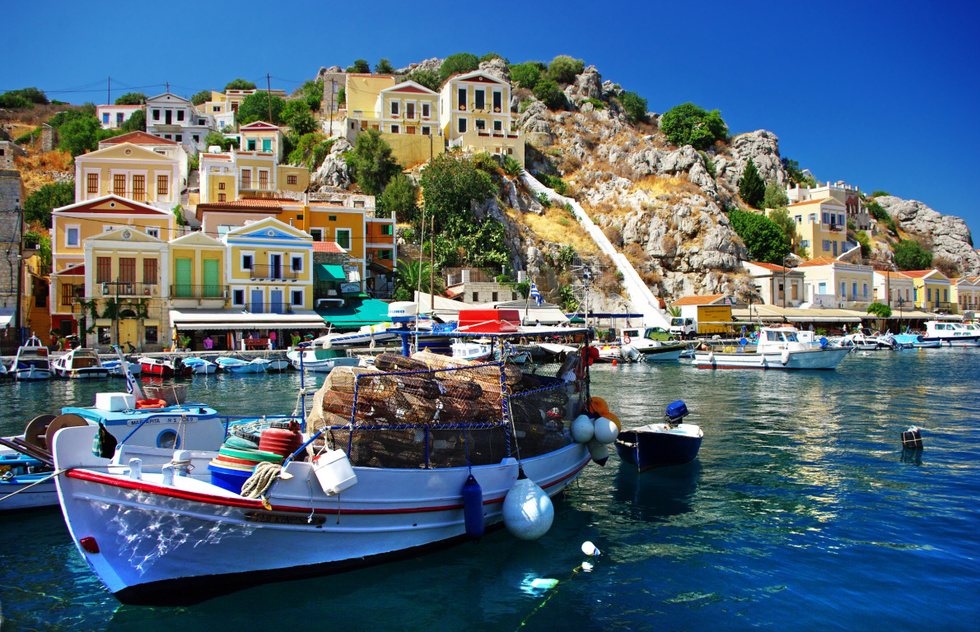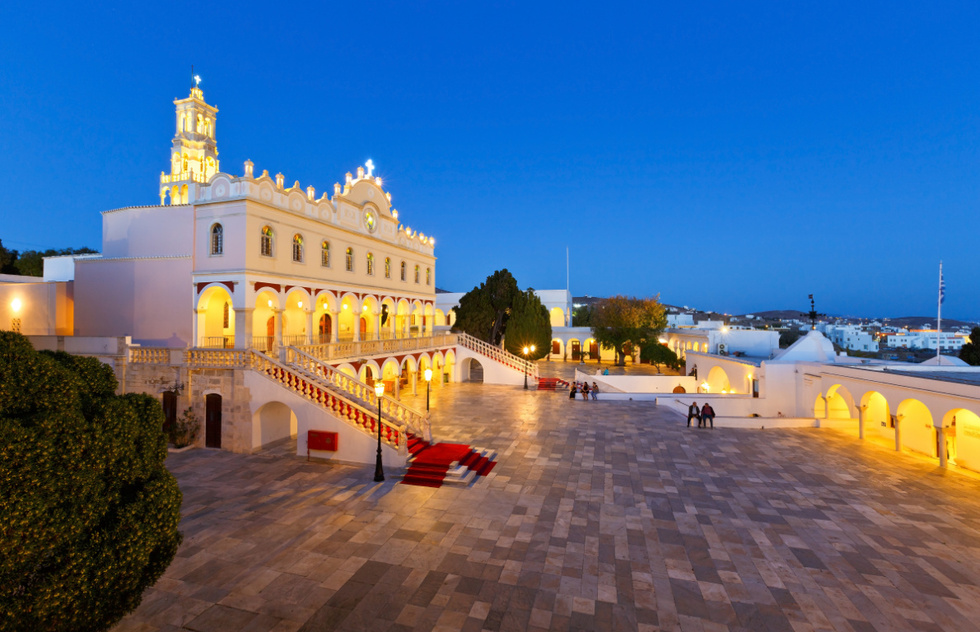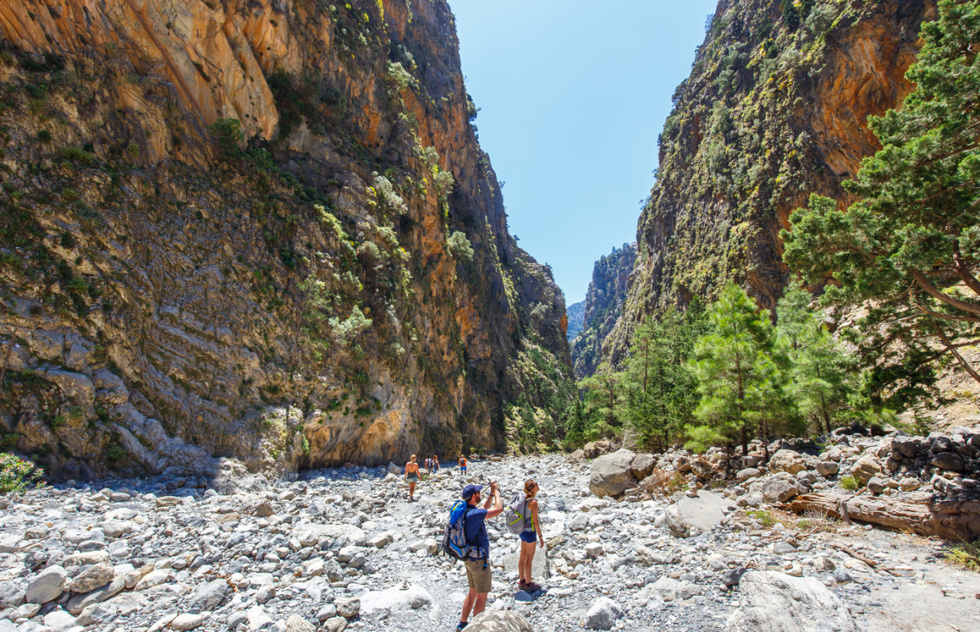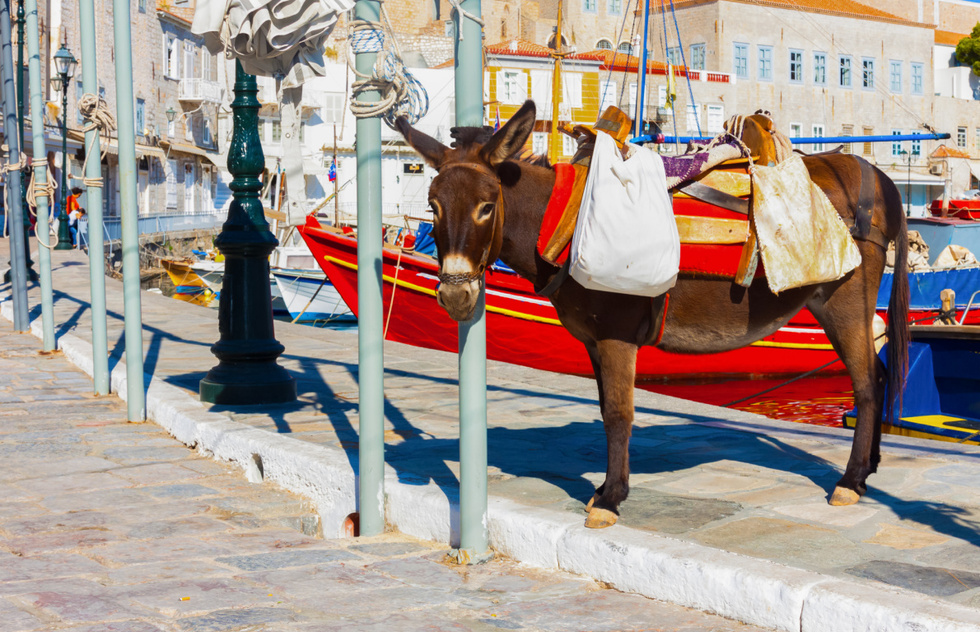Which Greek Islands to Visit to Avoid Crowds: 8 Great Escapes
By Stephen BrewerGreece’s most popular islands—Mykonos and Santorini chief among them—are more crowded than ever. For travelers dreaming of a quieter Greek island getaway, here are eight havens for enjoying turquoise waters, sandy beaches, shady village squares, alfresco meals, and all the other pleasures of a vacation in this enticing region. We can’t promise you’ll encounter a cooling breeze, but you will find fewer throngs.
Pictured above: a harbor on the island of Tinos
Travelers who go to the trouble to reach this remote outpost of the Sporades are met with one of the most remarkable sights in Greece—the spectacle of the white cubical houses of Skyros Town (pictured above) toppling down a steep mountainside. Far below is a string of beautiful sand beaches, backed by the low-key resort towns of Magazia and Molos.
Bordered by fragrant pine forests, additional stretches of sand ring the northern end of the cinch-waisted island, while the south is rocky, desolate, and hauntingly beautiful. Adding to the island’s otherworldly aura: the diminutive Syrian ponies you might see grazing alongside sheep and goats. According to legend, these sturdy little beasts pulled the chariot of Achilles to the Trojan War.
GETTING HERE: A few flights a week connect Skyros with Athens. Otherwise, it’s a 4-hour bus ride across the island of Evia, then a 2-hour ferry crossing from the port of Kymi.
This link in the Dodecanese chain ticks just about all the boxes for a Greek escape: sandy beaches, pretty villages, seaside tavernas, windmills, and even an imposing medieval castle. Despite these assets, few of the crowds who descend on nearby Kos and Rhodes find their way to Leros—which only adds to the island’s appeal.
Goats may be your only company on isolated beaches. Shady taverna terraces in the hilly old capital of Platanos are well suited to lingering over a coffee and pastry. The hilltop castle is a relic of the Crusader Knights of St. John, who landed here in the 13th century.
Another big presence was former Italian dictator Benito Mussolini; he made Leros his Eastern Mediterranean base and left behind the town of Lakki, where villas, the striking municipal cinema, and other landmarks are designed in an icy Italian Rationalist style.
Most accommodations on the island are in the nice little beach towns of Panteli and Alinda. A stay in either puts many other sights an easy stroll away.
GETTING HERE: Daily flights and an overnight ferry connect Leros with Athens. Boats run regularly to and from Kos, Patmos, Rhodes, and other stops in the Dodecanese.
When it comes to spectacular scenery, little Folegandros matches Santorini with spectacular cliffs and a picture-perfect main town, Chora—a blaze of white houses perched high above the blue sea. Similarities with Santorini end there, though, because Folegandros has none of the high-end luxury, nightlife, or crowds that characterize some of the island’s more famous Cycladic neighbors.
Age-old donkey paths cross the isle’s rock-strewn interior, arriving at beaches tucked into coves beneath the cliffs. Back in town, Chora’s three interlocking squares serve as theatrical settings for relaxed evening meals.
GETTING HERE: Folegandros is an hour away (though a world removed) from Santorini by a couple of daily fast boats.
The third-largest Greek island (after Crete and Evia) is tucked up against Turkey in the far eastern Aegean Sea, far off the typical island-hopping circuit. Lesbos made headlines in 2015 with the arrival of thousands of Middle Eastern refugees, but for the most part islanders go about their business here as they have for centuries, harvesting olives (9 million trees grow on Lesbos), fishing, and making ouzo.
Aside from an authentic Greek island experience, Lesbos offers great swaths of forests, soaring mountains, uncrowded beaches (including the 5.5-mile stretch of sand at Vatera), hot springs, a petrified forest, and salt marshes frequented by flamingos. Travelers settle into appealing seaside towns such as castle-topped Molyvos and beach-skirting Skala Eresou, where the ancient poet Sappho wrote verse that made the island’s name forever associated with erotic love between women.
GETTING HERE: An overnight ferry connects Athens and Mytilene, the colorful and cosmopolitan capital of Lesbos. Mytilene also has an airport with flights to and from Athens and, in summer, some other European cities.
Yialos harbor pops into view at the very last moment as ferries from nearby Rhodes and other Dodecanese ports round a barren promontory on what seems to be a desert island. Then, in a riot of bright ocher and pastel hues, tiers of handsome neoclassical merchants’ mansions come into view, climbing steep slopes from a tidy port.
No need to wander too far from this enchanting scene, as most of the island’s accommodations and tavernas are in Yialos. Reasons to venture farther include the climb up the 375 steps of Kali Strata (the Good Steps) to Chora, the whitewashed old capital. You can also follow the path out to Pedi, with a small beach backed by fish tavernas.
Boats make runs out to Panormitis and other isolated beaches and to the monastery of Taxiarchis Mihail Panormitis, an unexpectedly grand compound tucked away amid greenery in the remote southwest and dedicated to the patron saint of seafarers.
GETTING HERE: Taking a ferry from nearby Rhodes, it’s easy to visit Symi on a day trip—but try to settle in for a few days if your schedule allows.
While nearby Mykonos is a magnet for hedonists, Tinos attracts pilgrims to the Panagia Evangelistria (pictured above), Greece’s holiest shrine. Some of the devout approach the hilltop church from the port on their knees along a carpeted path.
Tinos is also one the most beautiful and least touristy islands in the Cyclades, where Pyrgos, Volax, and dozens of other pretty villages are nestled into valleys and clefts in barren mountainsides.
Paths that connect these whitewashed settlements wind past elaborate dovecotes and cross boulder-strewn, thyme-scented fields, making the island a walker’s paradise. Treks lead to secluded beaches and up Mount Tsiknias, a 2,400-foot-high summit that is allegedly the haunt of Boreas, god of the north wind. He makes his presence known when the summertime meltemi blows; fortunately, shady village squares provide welcome refuge from the winds.
GETTING HERE: A 30-minute ferry ride will bring you to Tinos from Mykonos.
The north of Greece’s largest and southernmost island is justly popular for the Venetian-Turkish cities of Chania and Rethymnon, the Minoan palace of Knossos, the sand-fringed lagoon at Balos, and the shores of Elounda with its luxury hotels. But the south of Crete, across the island’s spine of tall mountains, feels altogether different.
This is a land of deep gorges—the most famous, Samaria (pictured above), is only 14 feet wide and 1,000 feet high in places—isolated beaches (like Loutro) that can only be reached by boat, and relaxed little towns such as Myrtos, Sougia, and Paleochora.
GETTING HERE: Even remote spots in southern Crete are usually only an hour or two by car or bus from the sights and amenities of the north coast, making it easy to enjoy the best of two worlds.
One of the many charms of this barren, mountainous island is the absence of motorized vehicles. In place of cars and scooters, mules and donkeys laden with baskets clop along the cobbled lanes of Hydra Town, an amphitheater of beautifully preserved stone houses surrounding a café-lined harbor.
Many of the former sea captains’ mansions are now atmospheric hotels; more than a few guests have fallen for the island’s quaint charms and decided to extend their stays. Among famous expat residents was the late singer-songwriter Leonard Cohen, who wrote “Bird on the Wire” and “So Long, Marianne” while living on Hydra in the 1960s.
From Hydra Town, waterside paths follow the rocky coast to boulder-rimmed inlets where it’s hard to resist the urge to take a plunge. Excursion boats cruise from the port to Agios Nikolaos and other strands accessible only by water.
GETTING HERE: Athens is only an hour and a half away by ferry.
Stephen Brewer is the author of Frommer's Athens and the Greek Islands, available in paperback and e-book versions.





